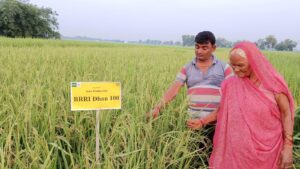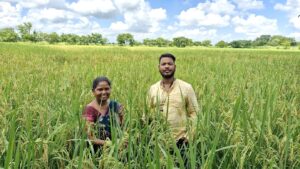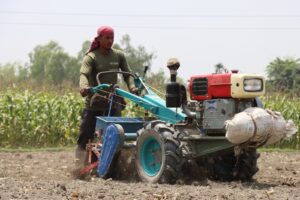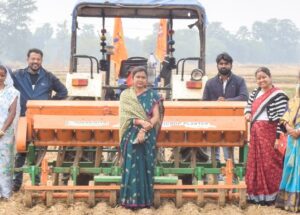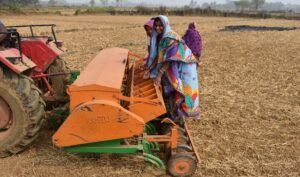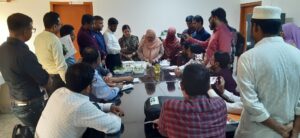
Somewhere within the halls of D.L. Umali Laboratory at the International Rice Research Institute (IRRI), two kindred hearts are smiling—Govinda Rizal and Shanta Karki, postdoctoral research fellows of the C4 Rice Project.
The C4 Rice Project is implemented by a team of experts from all over the world who look for a way to supercharge photosynthesis in rice and enable the plant to produce more grains than the current high-yielding varieties. Part of this team, on whose shoulders rests one of the biggest challenges of rice research, are Govinda and Shanta, two scientists who found not only a passion for science but also a deep love for each other. And, although IRRI varieties have always been a labor of love for science, the time will soon come when we can perhaps say, these grains are also a labor of people in love.
Shanta
Shanta Karki, a native of Lamjung, Nepal, is a molecular biologist and plant breeder who came to IRRI in July 2009 to join the molecular engineering team of the C4 Rice Consortium. Shanta grew up in a farming community and was exposed very early to agricultural problems. She yearned to help find a way to increase crop yield and, hence, specialized in molecular breeding techniques, working on wild rice species.
Her affinity with agriculture started at a very young age. “My family planted rice, and, as a small child, I had fun playing with mud,” says Shanta. “I was exposed to various areas of study as I got older but, somehow, I always knew I would end up in agricultural research.”
Did she always know she would end up with someone in agricultural research?
She smiles up to her ears and looks over at Govinda. He grins back.
Govinda
Govinda Rizal, from Lodrai in Gaylegphug, Bhutan, joined IRRI under the C4 Rice Project in April 2010—less than a year after Shanta did. He is also a plant breeder whose experience includes work on rice, soybean, and wheat.
At IRRI, he “hunts” for genes for the C4 syndrome among mutant sorghum populations. When his team finds such a gene, it is passed on to Shanta’s team to insert into rice.
Govinda had always wanted to pursue genetic engineering. As early as high school, he knew his mission was set. And yet, somehow, along the way, he made a few detours: he got himself a bachelor’s degree from North Bengal University in India; taught high school in Kathmandu, Nepal; and worked as an editor for a mathematics journal and a university association.
Despite the meanders, his path ultimately led him to Shanta.
“Love” and “science”

These two words, laid down a mere word apart, are, as everything else, easier said than done. But, the two IRRI plant breeders prove that love and science do go together.
Govinda and Shanta met in 1998 as undergraduate students (for Govinda’s second bachelor’s degree) at the Institute of Agriculture and Animal Sciences in Nepal. Since then—even though they were not together at first—Shanta’s and Govinda’s lives have become inevitably intertwined.
“We were best of friends, for a long time,” Govinda recalls, citing the friendship as the starting point for the attraction that later developed into something deeper. Shanta, on the other hand, said she was drawn to him because “we were both interested in science.”
Somewhere along the way, the two friends found they had more in common than a penchant for finding solutions to agricultural problems.
The two got married in February 2003, and then moved to Japan to do their master’s and doctor’s degrees in plant breeding at Kyoto University—on scholarships, alongside each other.
Common direction
When two paths merge and continue to advance in one direction without snags, it can mean only one thing— they were meant to be together. Govinda and Shanta have enjoyed a smooth relationship in the long time they have been together.
“We do not argue,” says Shanta. “If he is upset, he becomes quiet. It’s the same with me.”
Govinda nods: “Even in my family, no one quarrels. It’s just the way we were raised.”
Was the match always one-to-one?
“We do not have a lot of cultural differences, as Govinda also has roots in my country,” says Shanta. “The only thing, perhaps, is the way we like our food.”
“I eat everything,” Govinda starts, which Shanta finishes for him, “…except spicy food.”
Shanta, on the contrary, always needs extra pickles, chili, and salt on the side. “Until now, I have to cook two different dishes for a meal.”
Being with the C4 Rice Project, Govinda and Shanta have, in fact, signed up on a common mission to help ensure that the world’s population will have enough rice to go around long into the future. Is the difficult work ahead of them consistent with what they want for themselves?
“C4 is a long-term endeavor, and I plan to continue working for it,” Shanta says.
Govinda said that he had wanted to go back to Bhutan to help out, but eventually decided he no longer has to. “Working at IRRI, I feel that I am already working for my country.”
The C4 project evolved from an idea proposed by former IRRI scientist and now consultant John Sheehy and is now being led by Paul Quick. If a project has a John and a Paul at the helm, can a George and a Ringo be far behind? Can Govinda and Shanta be our George and Ringo? Only time will tell. What we do know is that this couple is here to stay—for each other, and to ensure that there is enough rice in everyone’s bowls long after the Beatles have all died.
____________________________________________
Ms. Leah Cruz is a writer-editor at IRRI

